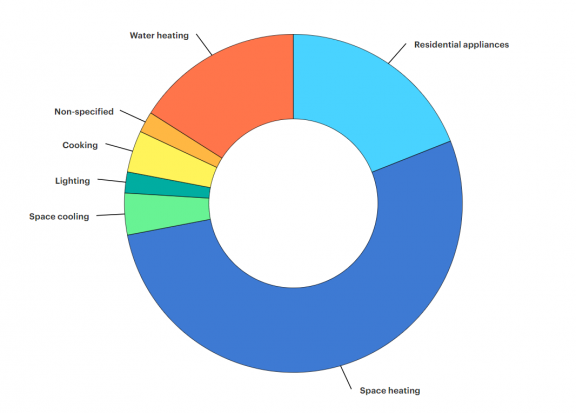The debate surrounding sustainable materials and sustainable construction methods is as old as our understanding of global warming itself. The debate has often been polarising, with academics typically advocating altruistic virtues whilst developers accused of short-termism, focused on profit above all else. Consumers are also not without blame. Saving the planet comes at a financial cost and most have not been willing and/or able to put their money where their mouths are.
Whichever side you sit on, the fact is that 40% of the UK’s emissions are generated from the Built Environment. The industry must accept and take responsibility, and the consensus is that the time to debate is over and action is now needed.
What will this new world look like and how do we resolve the disconnect between short term profit and long-term sustainability? In the past, most progress has come via sustainability focused planning policy forcing developers to change and incorporate build elements that would otherwise never have seen the light of day. This will continue. Environmental, Social and Governance (ESG) will also have huge financial and non-financial implications for developers meaning that adherence or otherwise will impact on profit.
So, there will be plenty of sticks and carrots to push sustainability. The poignant question will be which developers will grasp the opportunity and adapt, differentiate, and drive additional margin. As with other industries, it’s likely to be those that understand and anticipate the customer’s needs better than others that best exploit this opportunity. They will do more than just meet planning conditions and ESG metrics and rather create brand equity through their offering and credentials.
Environmental
The Built Environment currently accounts for approximately 40% of the UKs Carbon Footprint, that is 349,000,000 tonnes of CO2 per annum and around half is produced from the ‘residential’ sector, i.e. our housing stock. These emissions are generated from a combination of the construction of new buildings, existing homes through operational use, i.e. heating and electricity use (see use chart below for operational breakdown) and through the transportation of building materials. To put these emission into perspective, the Empire State Building weighs roughly 365,000 tonnes – so the equivalent would be a thousand Empire State buildings being put into the atmosphere every year, like a giant canopy trapping heat. The more carbon is produced, the thicker the canopy and the warmer the planet, a.k.a. Climate Change.
CO2 levels can be measured going back hundreds of thousands of years and are higher now than we have seen for the past 800,000 years. Making significant changes to this contribution to climate change has the potential to substantially improve the UK Carbon Footprint.

Governance
Policy is rapidly changing, with many Local Plans now presenting more stringent guidelines, requiring new builds to achieve ‘Net Zero Operational Carbon’. This means that a new home will be required to reduce its demand for energy in the first instance and then produce its energy from renewable sources. Any excess emissions will then likely be ‘offset’ by paying into a council led fund which will contribute to either generating energy or capturing carbon elsewhere, such as providing additional solar panels to schools and afforestation, respectively.
Reading Council adopted a new Local Plan in 2019 and the first policy is a ‘Presumption in favour of Sustainable Development’. All new major-residential development within Reading must now be ‘zero carbon’ (Policy H5) and where zero carbon cannot be achieved, financial contributions are required to offset any excess CO2 emissions (Policy SI2).
In using policy to steer developments toward ‘net-zero operational carbon’, housing developers and industry professionals will become accustomed to the new technologies and construction methods required to make this financially feasible. This should result in a higher quality of housing stock, with better energy efficiency, lower bills and significantly less carbon.
So, is this enough? The short answer is no. The long answer is that emissions from buildings don’t just emanate from ‘operational’ use and designing for net zero operational carbon (the yellow part in the below diagram) will only result in a 67% saving of the CO2 associated with that dwelling. The other 33% of emissions can be monitored and reduced through a ‘Whole Life Cycle Assessment’ (WLCA). The WLCA looks at the embodied carbon (the carbon associated with the production of a material) associated with construction materials, the lifespan, maintenance, and transportation to the development site.

(Source: LETI Embodied Carbon Primer)
WLCAs are quite new in the construction industry, but their potential to help emissions are huge. Embodied carbon accounts for approximately 20% of emissions associated with the construction of a new house. The assessment can calculate which materials are ‘heavy hitters’ in terms of carbon and alternative materials can be sourced with much lower associated emissions. At present, the London Plan is one of the only Regional Plans which mandates that a WLCA is prepared with planning applications, and it is likely that other local plans will follow suit soon. For developers, pre-empting this change could be a critical first step in future-proofing their business strategy.
Planning policy is rapidly changing toward specifying low/ zero carbon developments. The buzzword, ‘net zero’ is very much in full swing and far from reaching its peak. Over the next decade, developers should expect to see more local authorities follow suit, each specifying their own carbon targets for operational and embodied carbon, which will be achieved through careful design and material specification.
“Planning policy and building regulations have done a good job in navigating development toward low operational carbon. I imagine that we will now start to see a comparable focus with embodied carbon over the next decade, to a point where new developments will one day proudly boast low carbon on embodied, and operational fronts” – Ollie Eggenton, Love Design Studio.
Social
Aside from policy driven change, the Intermediary Mortgage Lenders Association recently announced that 77% of lenders are planning to release ‘green mortgages’ to home buyers which are cheaper or priced the same as a typical product. With social status beginning to be attributed to personal sustainability efforts, we would expect developers to see a rise in the number of home buyers and mortgage brokers alike, asking for the sustainability credentials of their developments. Therefore, the home builders who get a move on and prioritise sustainability now, will soon have a product that is more affordable to a wider market because of better mortgage rates.
The attitude and approach to creating a more sustainable lifestyle has shifted significantly in the last few years with many individuals changing their personal habits, diet, purchase behaviour and transportation to be more sustainable. As an example, at the end of October 2021 there were more than 675,000 plug-in vehicles registered and last year saw the biggest annual increase in number of registrations, showing a huge growth of 66% on 2019. This particular change will directly impact developers who must now cater to home buyers that demand the ability to charge their vehicle. This doesn’t just mean adding a small number of car charging points within a development, there should be the electrical capacity to serve the total number of vehicles at each individual dwelling, to cater to the growing demand and future needs.
“I have worked as a sustainability consultant within the construction industry for over a decade now so I have seen how the residential sector has transformed in that time. When I first began, sustainability was deemed a box-ticking exercise for design teams and developers; now it leads the narrative on every single project from conception to completion. The urgency for lower emission buildings is being driven by policy but steered by the construction communities i.e. developers, local authorities, consultants and architects. I’d love to see it being driven further by the homeowners themselves.” Andy Love, Director at Love Design Studio.
How can we do better?
There is no doubt that over the course of the next few years the construction industry will have to become ‘net-zero’. This will be achieved through changes to policy and by buyer demand for a ‘green’ home.
The transition will likely be an arduous one, with work forces requiring retraining as policy changes, to understand how to facilitate low carbon designs and how to implement low carbon technologies on site. Developers who now target to exceed sustainability criteria will be giving themselves a head start; by staying one step ahead of policy developers can prepare staff and adjust the business strategy to accommodate for any new materials and processes required.
Love Design Studio are a consultancy that are advising Local Authority’s and developers on how to achieve net-zero carbon in operation and whole life-cycle carbon. Sustainability consultants now sit at the front-end of any major development along with the architect, client, and engineers and for good reason. A Sustainability Officer within a Local Authority will never turn you away for going above and beyond, but they will for the opposite, and with the changes in attitude and policy approaching, this could have a significant negative impact on developers.
Success will come for those who act now. The technologies and knowledge are there, tried and tested, they just need to be put into effect. When we all manoeuvre the massive challenge opposed by climate change in a proactive manner, economies of scale will arrive, others will follow, and ultimately, we will wish we had started the journey to net-zero sooner.
This article was written by Ollie Eggenton, Sustainability Consultant at Love Design Studio and Haslams Estate Agents. Ollie’s line of work focuses on zero-carbon buildings and holistic sustainable building design; covering such elements as overheating, energy strategy, sustainability certification and whole life-cycle analysis. Love Design Studio helps design teams within the built environment create sustainable spaces and buildings.

